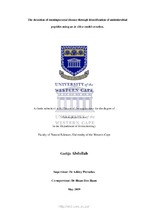| dc.description.abstract | Neisseria meningitidis (the meningococcus), the causative agent of meningococcal disease (MD) was identified in 1887 and despite effective antibiotics and partially effective vaccines, Neisseria meningitidis (N. meningitidis) is the leading cause worldwide of meningitis and rapidly fatal sepsis usually in otherwise healthy individuals. Over 500 000 meningococcal cases occur every year. These numbers have made bacterial meningitis a top ten infectious cause of death worldwide. MD primarily affects children under 5 years of age, although in epidemic outbreaks there is a shift in disease to older children, adolescents and adults. MD is also associated with marked morbidity including limb loss, hearing loss, cognitive dysfunction, visual impairment, educational difficulties, developmental delays, motor nerve deficits, seizure disorders and behavioural problems. Antimicrobial peptides (AMPs) are molecules that provide protection against environmental pathogens, acting against a large number of microorganisms, including bacteria, fungi, yeast and virus. AMPs production is a major component of innate immunity against infection. The chemical properties of AMPs allow them to insert into the anionic cell wall and phospholipid membranes of microorganisms or bind to the bacteria making it easily detectable for diagnostic purposes. AMPs can be exploited for the generation of novel antibiotics, as biomarkers in the diagnosis of inflammatory conditions, for the manipulation of the inflammatory process, wound healing, autoimmunity and in the combat of tumour cells. Due to the severity of meningitis, early detection and identification of the strain of N. meningitidis is vital. Rapid and accurate diagnosis is essential for optimal management of patients and a major problem for MD is its diagnostic difficulties and experts conclude that with an early intervention the patient’ prognosis will be much improved. It is becoming increasingly difficult to confirm the diagnosis of meningococcal infection by conventional methods. Although polymerase chain reaction (PCR) has the potential advantage of providing more rapid confirmation of the presence of the bacterium than culturing, it is still time consuming as well as costly. Introduction of AMPs to bind to N. meningitidis receptors could provide a less costly and time consuming solution to the current diagnostic problems. World Health Organization (WHO) meningococcal meningitis program activities encourage laboratory strengthening to ensure prompt and accurate diagnosis to rapidly confirm the presence of MD. This study aimed to identify a list of putative AMPs showing antibacterial activity to N. meningitidis to be used as ligands against receptors uniquely expressed by the bacterium and for the identified AMPs to be used in a Lateral Flow Device (LFD) for the rapid and accurate diagnosis of MD. | en_US |

